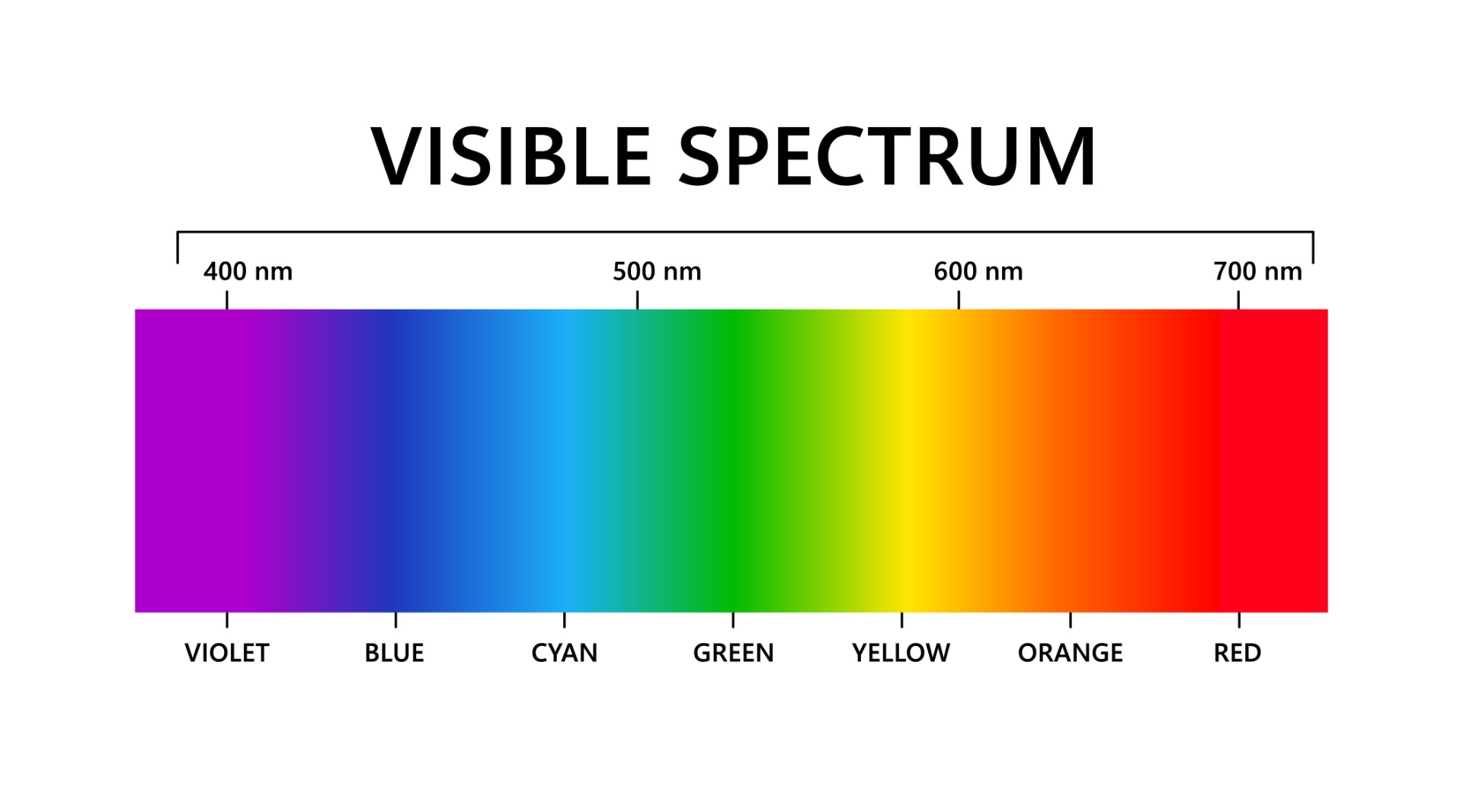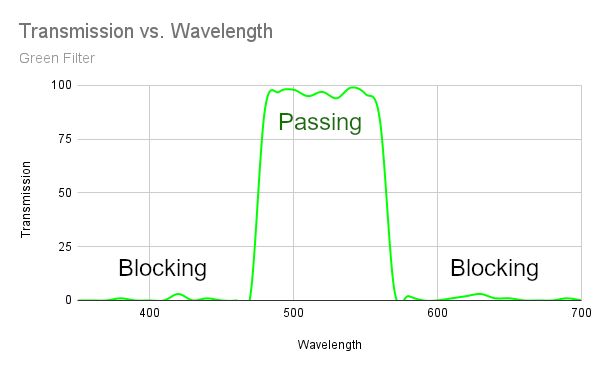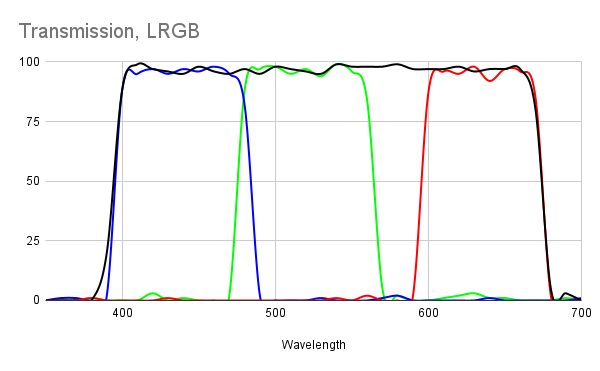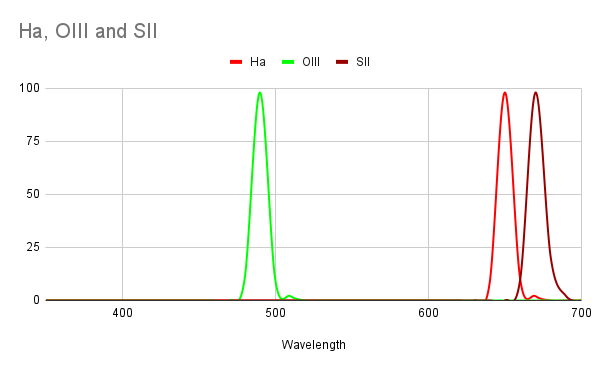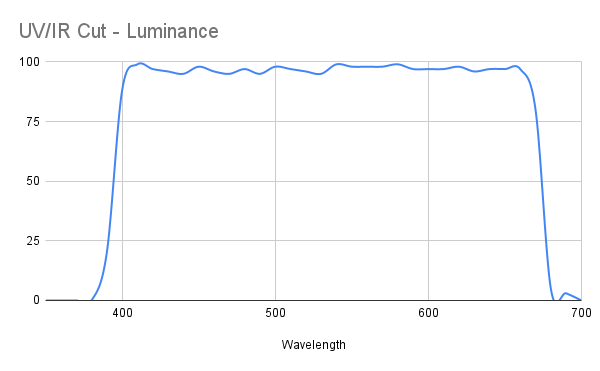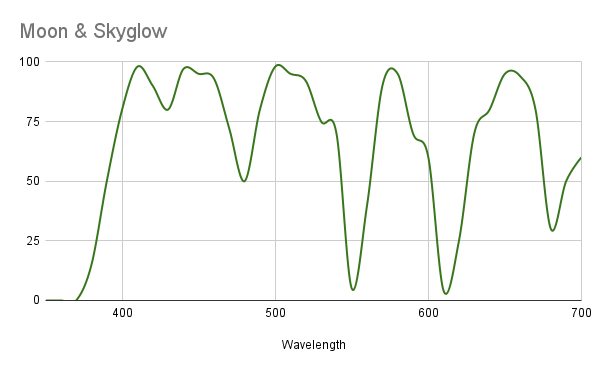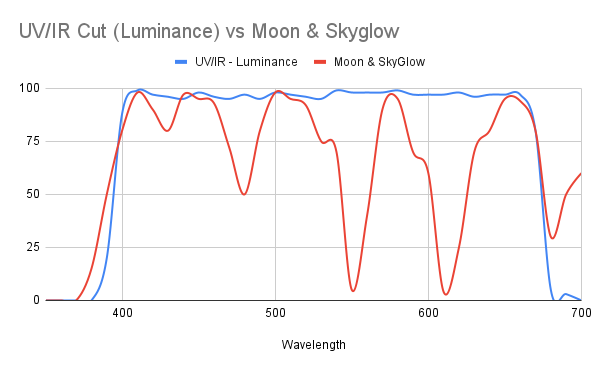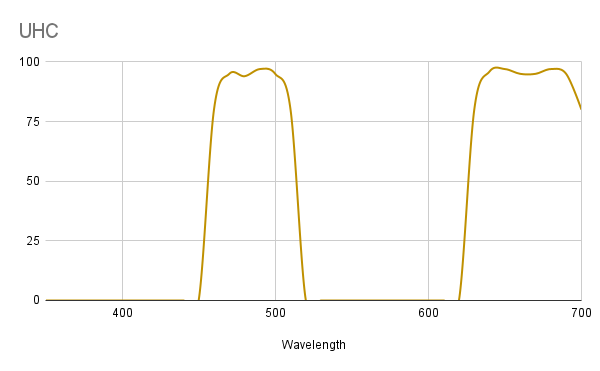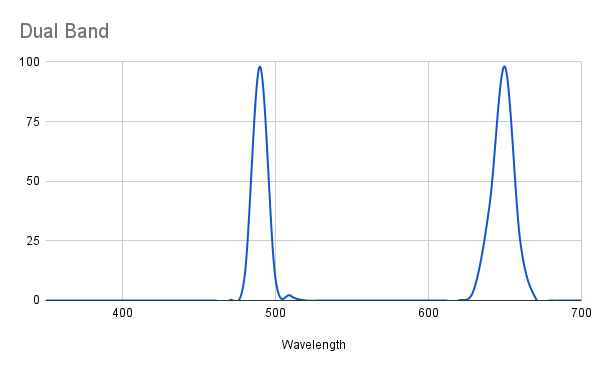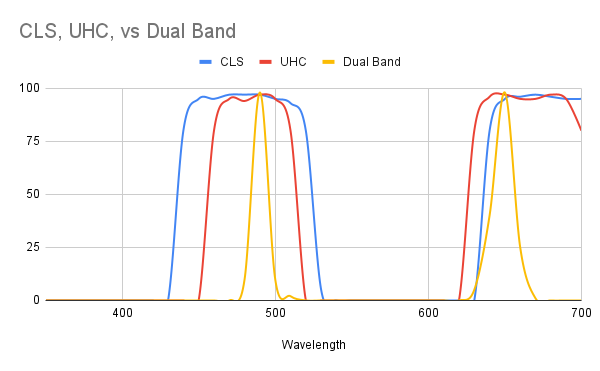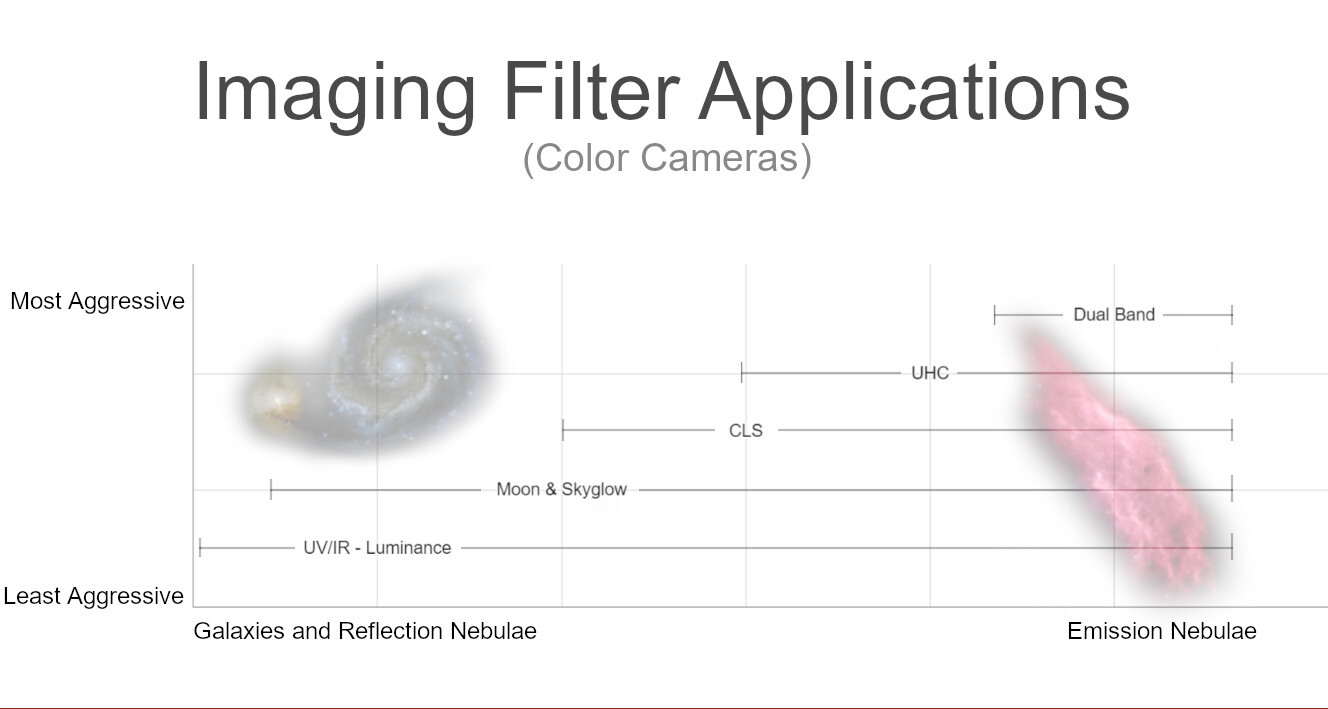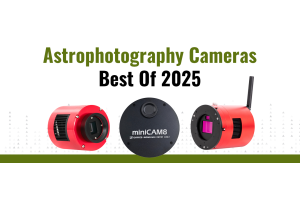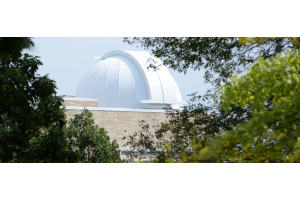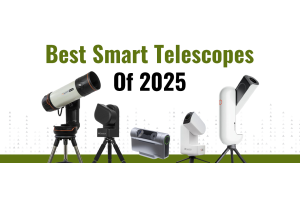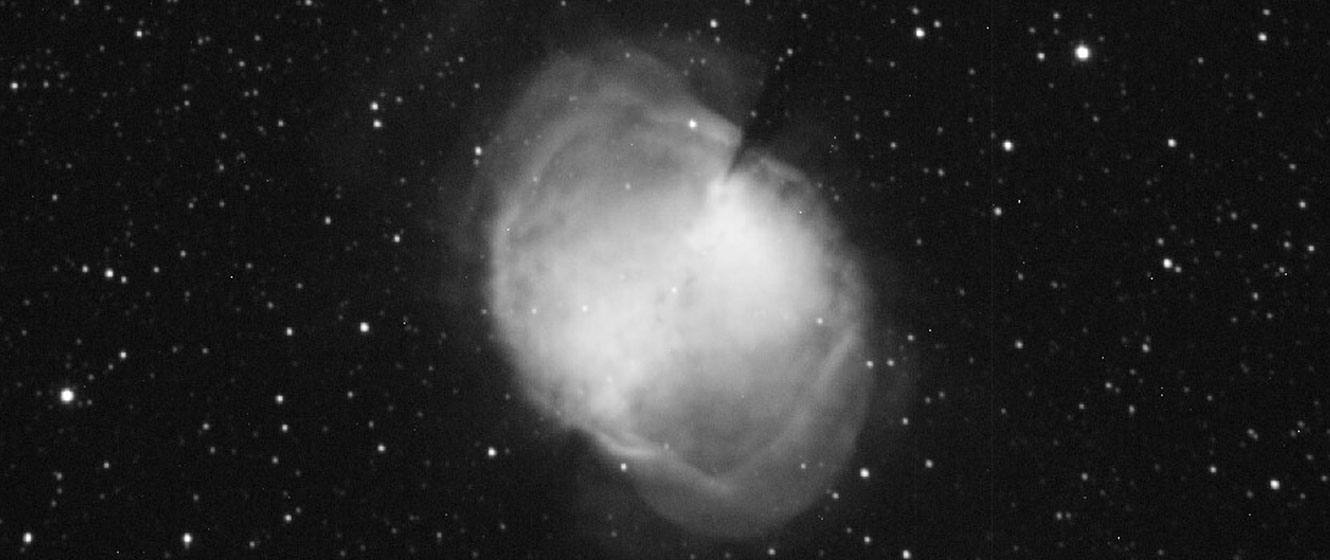
Astronomical filters work by blocking certain types of light and allowing other types to pass through almost unaltered. Filters do not enhance or multiply light; they simply block undesired wavelengths.
Visible light is made up of different wavelengths; longer wavelengths are red and shorter wavelengths are violet. When designing a red filter for manufacture, the filter will be made so that it blocks all of the light that is not red and allows as much of the red light wavelengths as possible to pass through. The same can be said for a blue or a green filter. The filter will be designed and manufactured so that it blocks the undesired wavelengths and only allows a portion of the spectrum to pass through, much like how a pair of tinted sunglasses function.
Transmission charts will typically be laid out with the percentage of light which passes through the filter being listed in the left axis and the wavelength of light being listed on the bottom axis. Usually the shorter wavelength will be on the left and the longest on the right. A green imaging filter can look something like the following graph. Take notice that the filter does not only pass the very narrow wavelength that would be a “perfect” green, but it also passes a large region before and after this ideal wavelength. Allowing this larger range of wavelengths gives a good signal, and when combined with blue and red filters, covers the whole visual spectrum.
Another type of filter is a Luminance or UV/IR cut filter. These filters encompass all of the wavelengths that Red, Green, and Blue cover, but in a single filter. In the following image there are four filter transmissions on one chart: Luminance, Red, Green, and Blue (LRGB).
When light is emitted by ionized gasses it will be in a very narrow wavelength of light. Each different element or type of ionized gas will emit a unique wavelength of light. Looking at an older street light, it might appear to be a very yellow color, an older fluorescent lightbulb might have a green tint to it. The sodium and mercury lights used for city lighting follow the same general laws of physics as space gas and emit an extremely narrow band of light. We could take advantage of this and choose astronomical filters that block these wavelengths, therefore blocking the local light pollution from our images. Low pressure sodium vapor lighting, the yellowish tinted street lighting, emits at a very specific 589 nm wavelength. Looking back at the previous LRGB transmission chart, we can see the red and green filters are split in this area, the red blocking that wavelength and the blue also blocking this wavelength. This is a simple light pollution filter that can be built into the LRGB filter set. It’s not something that we need to worry about or focus on when doing LRGB imaging, but it is a clever use of filters for standard RGB imaging without a luminance filter and a concept to keep in mind while progressing through this document.
Light pollution filters usually block portions of the spectrum where street light emissions are and allow most other portions of the spectrum to pass through to the camera sensor. Some of these filters are known as Moon and Sky Glow, CLS, or UHC. It is important to note that using filters on color cameras will cause a color cast to be seen on unedited images. Anytime a large portion of the visible spectrum is blocked the color balance will be off. This can be compensated for when processing the images, but you can never replace the light that is not recorded. The possibility of non-natural colors is the trade off for increased contrast. This is true with all filters and is not specific to any one brand.
In amateur astronomy, there are a few wavelengths of light that are of specific interest, and you might have heard of them before: Hydrogen Alpha line, Oxygen III line, and SII line. There are entire books written on the subject, but it’ll be kept pretty simple here. We recommend more advanced reading on the subject of astronomical emission lines, as it’s very interesting. For our purposes here, It will suffice to say these three are the strongest light emissions from gaseous nebulae1:
- Ionized Hydrogen (Ha or HII) 656.28 nm
- Doubly Ionized Oxygen (OIII) 500.7 nm, 495.9 nm
- Ionized Sulfur (SII) 672.4 nm
These gaseous nebula include, but are not limited to, large diffuse nebula like the North American Nebula (NGC7000), star forming regions like the Orion Nebula (M42), and planetary nebula like the Dumbbell Nebula (M27). Using the different filters, different structures within each nebula become visible. The following three images show how extreme the difference in details can be from one emissions line to the next. The images are single fifteen minute exposures with 12nm Astronomik filters.
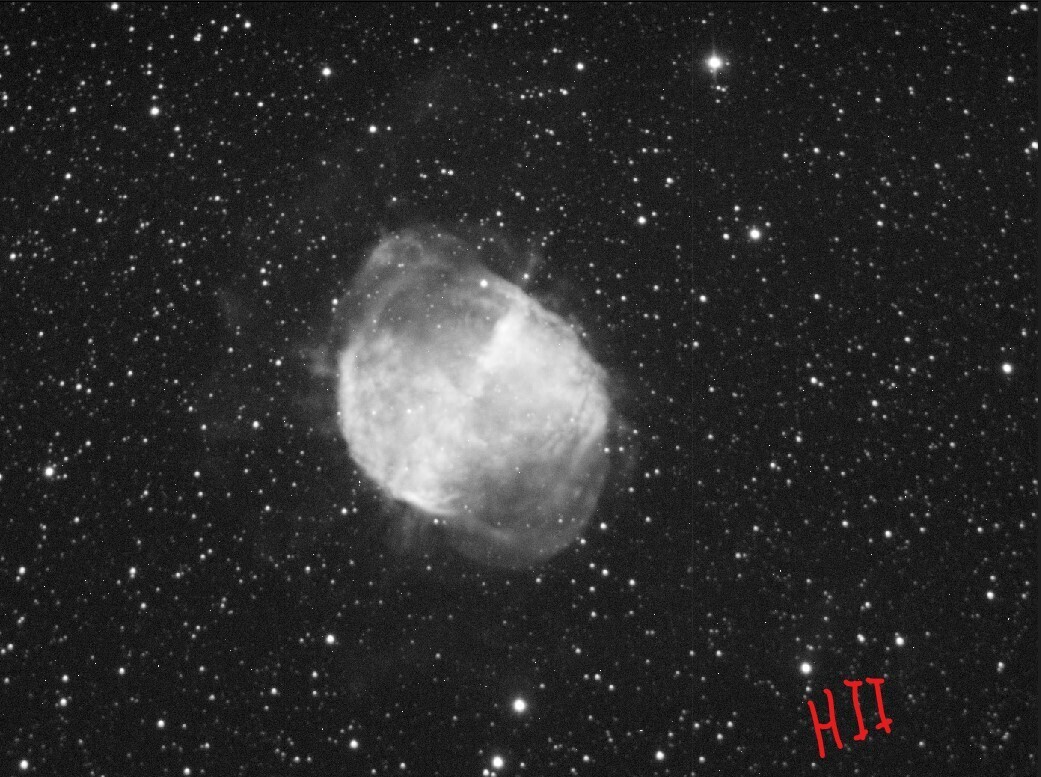
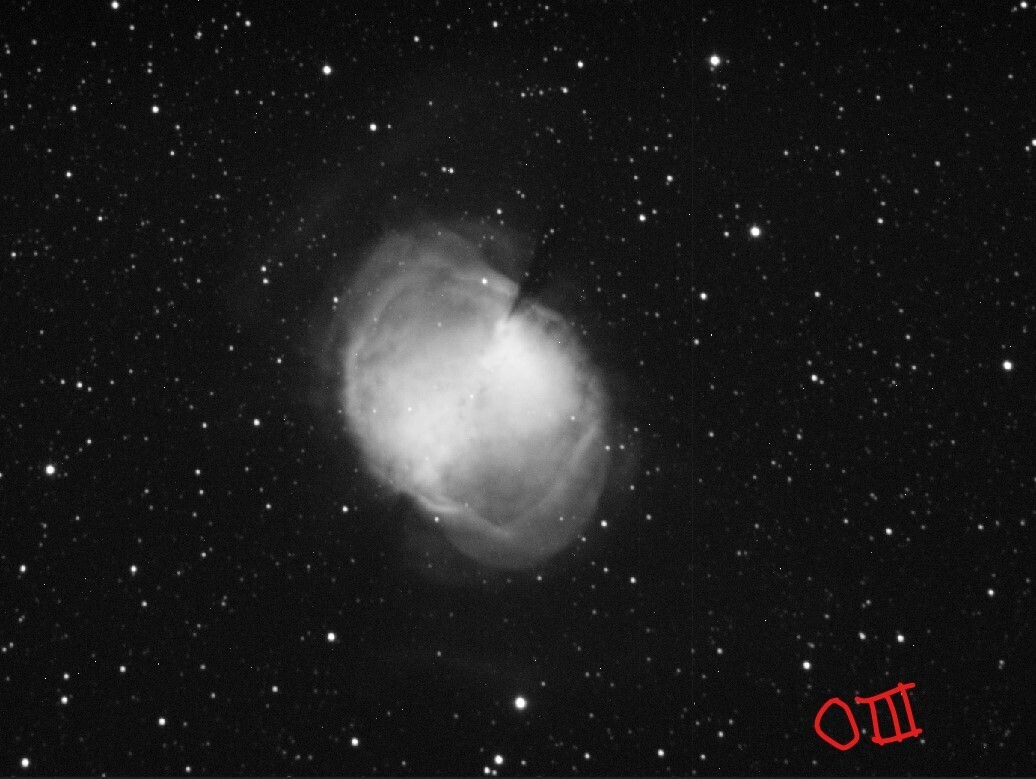
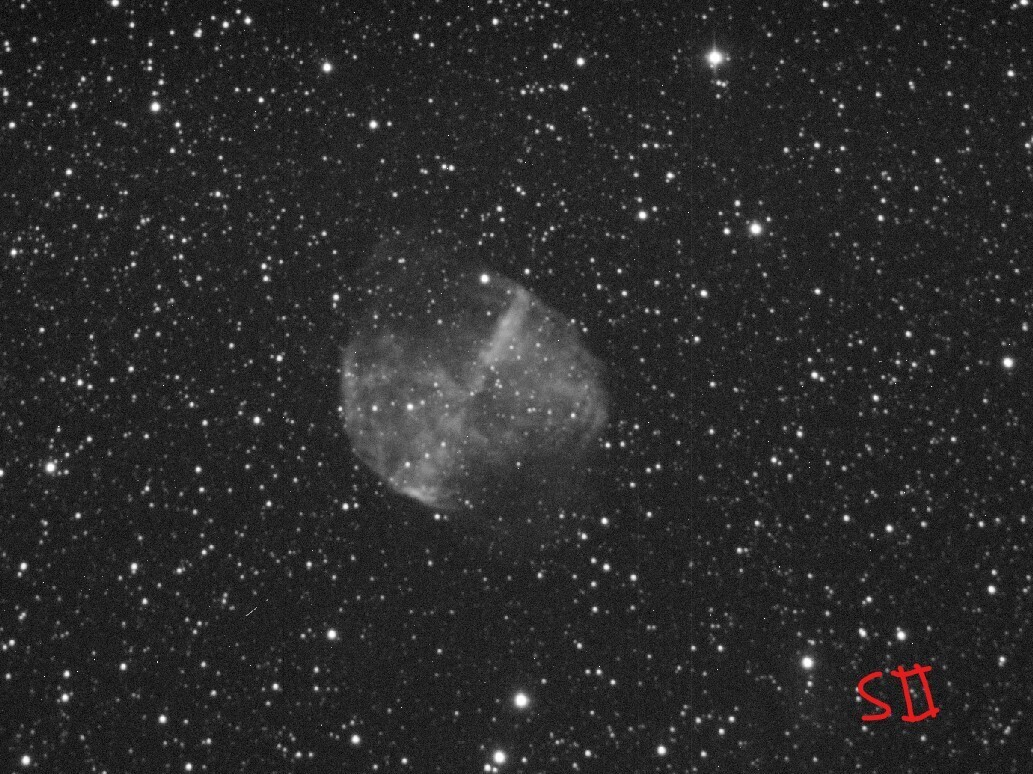
Narrowband imaging filters come in different offerings. They are listed by the “Full Width Half Maximum” of the transmission, i.e. how wide the transmission is when measured halfway up the chart. Typical FWHM ratings are 12nm, 6nm, and 3nm.
Recently manufacturers have combined narrowband technology with aggressive color camera filtering techniques and have created multichannel narrowband filters that work well with color cameras. They offer very high-contrast images of emission nebulae without the complexities of a monochrome imaging system. Though, single bandpass filters like those used in the three images above are normally used with a monochrome camera system.
12nm filters offer high transmission rates and are well suited to many systems, especially small aperture or long focal ratio telescopes that might lack the light throughput of a larger telescope. 12nm filters still offer a massive increase in contrast over a generic light pollution filter or CLS filter. I, for example, started with and currently use 12nm filters as they offer a very high value per dollar. The wider 12nm filter allows for good light transmission and bright images.
A narrow filter bandpass will give a higher contrast image with the potential to see much finer detail in the structures of a nebula. 3nm offers the highest contrast while 6nm is a mid-range filter option that has been extremely popular over the years. Some manufacturers also offer a 7nm or 7.5nm filter which can be thought of as being the same application as a 6nm filter.
The following image shows three different narrowband filters; Ha, OIII, and SII. Notice how little light transmission there is when compared to the RGB filters. This means that the total integration times typically need to be much longer than RGB imaging in order to have a clean, low noise image in areas of low signal, such as the background; though the contrast of an emissions target like M27 the Dumbbell Nebula will be much higher.
How much do narrowband filters increase contrast?
The following two images help to paint the picture:
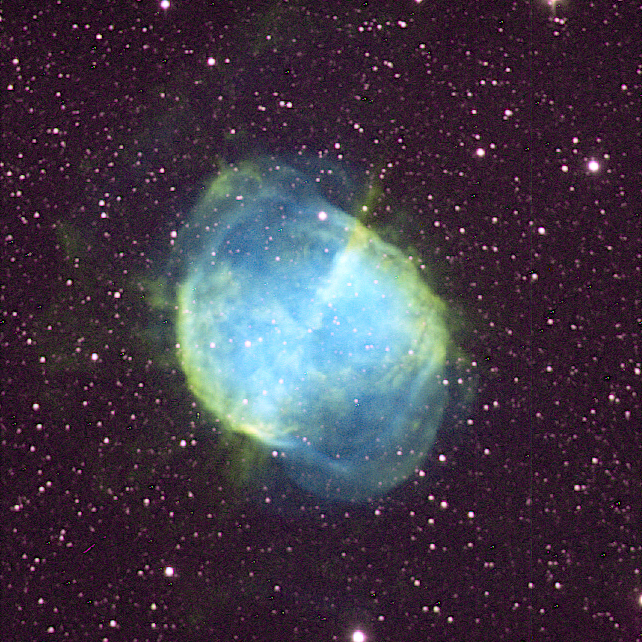
45 min with a TOA130 and ICX825M using 12 nm SHO Filters.
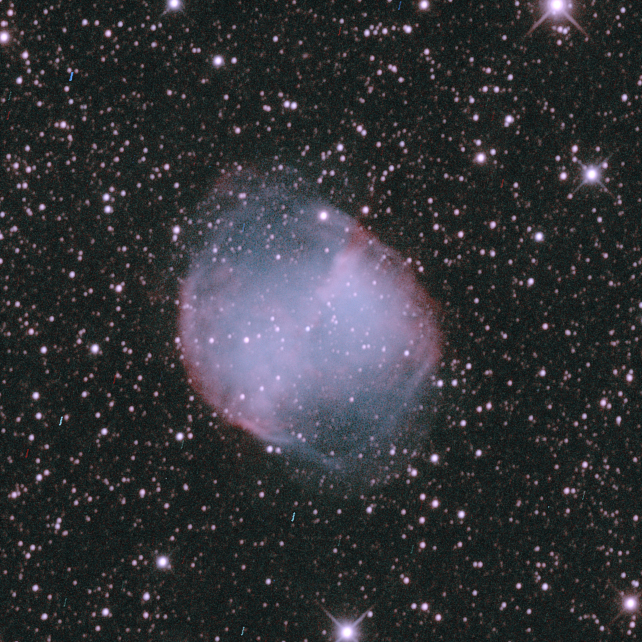
84 min with a 150mm RC and IMX094C using no filter.
General Filter Types for Color Cameras and Their Applications
UV/IR Cut - LUM
Luminance filters and Ultraviolet / Infrared (UV/IR) Cut filters are two different names for the same filter. When using a monochrome camera, the filter is referred to as a Luminance filter and is usually sold in a set with red, green, and blue filters. When this filter is used with a color camera, the filter is often referred to as a UV/IR cut filter, and they are sold individually. The UV/IR cut filter will block ultraviolet and infrared light which refractive optics typically do not focus well. These filters pass almost all of the visible spectrum at a high transmission rate. The following image is an example of what might be seen for a UV/IR cut transmission chart. If the pass area was narrower, blocking more of the UV and IR ranges, the filter might perform better in less corrected doublet refractors. Conversely, a wider UV/IR cut filter could work better for a well corrected triplet refractor which uses ED glass, though most generic UV/IR cut filters will work well in all telescopes. This is the least aggressive filter that can be used with a color camera for astronomical imaging. It is not used for visual observations.
Moon & Skyglow
Moon and Skyglow filters are the next step up from a UV/IR cut filter when it comes to blocking light pollution and increasing the contrast of emissions targets. These filters are also suitable for imaging full spectrum objects like galaxies and reflection nebulae. These filters block key areas of the spectrum where light pollution is likely to be seen but passes most other portions of the spectrum. This allows the imager to record data as close as possible to true color while still blocking light pollution and increasing contrast on emissions nebulae. Some filters which are very similar to Moon and Skyglow, but are a bit more aggressive, are those like the Optolong L-Pro and L-Quad. The transmission chart of a Moon and Skyglow filter will look similar to the following. There will be areas of high transmission for Hydrogen Alpha, Hydrogen Beta, OIII, and SII. There will be low transmission areas where the main lines for mercury and sodium vapor lamps emit light, which also loosely correlates with some LED street lighting. Some Moon and Skyglow filters might block IR light more than others. It is a mild and fairly universal filter and is used visually as well as for mild photographic filtration.
UV/IR Cut vs. Moon & Skyglow
The UV/IR cut and Moon and Skyglow filters have a similar application, and it is worth making a brief comparison between them. Notice that both filters span the same primary transmission area and generally block the light outside of this range. The Moon and Skyglow filter blocks some of the unwanted light pollution but is otherwise fairly similar. If your local light pollution allows for it, the UV/IR cut will usually be the best choice for imaging galaxies and reflection nebulae.
City Light Suppression (CLS)
CLS filters are the next step in light pollution reduction. They aggressively block huge portions of the visible light spectrum, passing two large sections that contain emissions lines from astronomical objects. This filter, as with all of those that will follow, drastically changes the color balance when used with color cameras. This color balance change is due to the large section of the visible spectrum which is not permitted to pass through to the camera sensor. By removing portions of the visible spectrum it is impossible to have a natural color balance. This is independent of the filter brand and is a byproduct of all aggressive filters. A positive tradoff for this color balance change is a large gain in contrast when imaging emissions nebulae, when compared to the less aggressive filters. Notice the large blocked portion in the following transmission chart. The CLS can be used visually or for astrophotography.
Ultra High Contrast (UHC)
UHC filters follow the same form and function as a CLS filter, though the area that is blocked is much larger and the wavelengths that are allowed to pass through are even narrower. This further increases contrast on emissions nebulae. This filter is not well suited for imaging galaxies unless there is a special interest in the Hydrogen or Oxygen emissions from that galaxy. The filters work well with smaller telescopes and longer focal ratios as they still pass a moderate amount of light overall. The UHC filter is extremely popular for visual use and can also be used for photography, though some manufacturers make a specific UHC for imaging which offers better IR blocking.
Another filter which is similar to a UHC, but is more aggressive in its light blocking, is the Optolong L-eNhance.
Multiple Bandpass
Multiple Bandpass filters operate similarly to narrowband imaging filters with the exception that they allow for several different narrow emission bands to pass through. Rather than just allowing Hydrogen Alpha or OIII, it might allow for both at the same time. These imaging filters are referred to as Dual-Band, Tri-Band, or Quad-Band depending on how many individual emissions lines are permitted to pass. This filter design offers the highest contrast available with a color camera when imaging emissions nebulae and planetary nebulae. Some examples of the Dual-Band filter would be the Optolong L-Extreme and the L-Ultimate. The L-Ultimate offers the highest contrast with the very narrow 3nm bandwidth. The same ideas that apply to monochromatic narrowband imaging apply to these specialty filters. Wider bandpasses allow for more light to pass through and are generally brighter and less costly. The narrower bandpass filters offer the highest contrast but also the highest costs. An example of a dual-band filter is as follows:
Note: There are filters on the market which use the “Quad” nomenclature but are not a multi-narrowband filter. Please double check the filter’s transmission chart before making a purchase.
Comparing the CLS, UHC, and Dual-Band Filters
The following transmission chart shows the three filter transmissions overlaid. It is easy to see the similarity in these filters when looking at the areas that are blocked and the wavelengths that pass. There is a large difference in bandwidths. While they serve the same general purpose, the contrast in the final image will be completely different. For a cost effective,possibly more natural color, and an improved image, you should consider the CLS filter. For a step up in contrast, the UHC would be the best choice. For the ultimate contrast on those particularly difficult to image emissions nebulae, the Multi-Band filter is usually the best choice. Keep in mind, as bandpass narrows, the low signal areas of an image might take more integration time in order to reduce noise.
A quick reference chart
The following chart lists all the major categories of color camera imaging filters. The left axis lists the aggressiveness of the light blocking. The bottom axis lists the type of possible astronomical object imaged with the filter. From the left side the full spectrum is represented, all the way to narrow emissions nebulae on the right. Notice all filters can be used to capture an emissions nebula, but not all filters can be used to image the full spectrum. That is not to say a galaxy cannot be imaged in narrowband as they can be and the resulting images can be quite striking. However, it is not a common practice in the hobby today, and it does not produce the type of result typically expected when imaging galaxies.
There are many different options for filters and what is best for one application might not be the best for another. Knowing how to read the transmission chart, what light wavelengths you might want to block for light pollution, and knowing what wavelengths your target emits will help you choose the best filter for your application. If the emissions of a specific object are unknown, an internet search should provide the information necessary to choose the best filter. Remember, astronomical filters do not enhance or multiply light; they simply block the undesired wavelengths and allow other light to pass through to the camera sensor.
1 "How to take Hubble-like photos: Filters and post-processing guide," Astronomy Magazine, Astronomy, Accessed June 20, 2024, https://www.astronomy.com/observing/observing-basics-image-like-hubble

Learn More
Interested in learning more about astrophotography, filters, and more? Not sure where to begin? Check out our Astronomy Hub!
Click the arrow above to see MLA, APA, and Chicago Manual of Style citations.
MLA:
Paul, Matthew. "How to Read a Filter Transmission Chart and Choose a Filter," AstronomyHub, High Point Scientific, 9 Jan. 2025, https://www.highpointscientific.com/astronomy-hub/post/how-tos/how-to-read-a-filter-transmission-chart-and-choose-a-filter.
APA:
Paul, M. (2025, January 9). How to read a filter transmission chart and choose a filter. High Point Scientific. https://www.highpointscientific.com/astronomy-hub/post/how-tos/how-to-read-a-filter-transmission-chart-and-choose-a-filter
Chicago Manual of Style:
Bibliography:
Matthew Paul. "How to Read a Filter Transmission Chart and Choose a Filter," AstronomyHub (blog), High Point Scientific, January 9, 2025. https://www.highpointscientific.com/astronomy-hub/post/how-tos/how-to-read-a-filter-transmission-chart-and-choose-a-filter.
Footnote:
Matthew Paul, "How to Read a Filter Transmission Chart and Choose a Filter," AstronomyHub, High Point Scientific, January 9, 2025. https://www.highpointscientific.com/astronomy-hub/post/how-tos/how-to-read-a-filter-transmission-chart-and-choose-a-filter.
This Article was Originally Posted on April 3rd 2024





